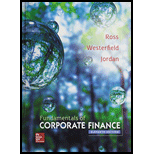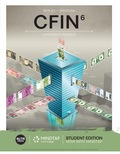
Fundamentals of Corporate Finance with Connect Access Card
11th Edition
ISBN: 9781259418952
Author: Stephen A. Ross Franco Modigliani Professor of Financial Economics Professor, Randolph W Westerfield Robert R. Dockson Deans Chair in Bus. Admin., Bradford D Jordan Professor
Publisher: McGraw-Hill Education
expand_more
expand_more
format_list_bulleted
Question
Chapter 20, Problem 20QP
Summary Introduction
To determine: The number of orders per year.
Introduction:
Break-even price is a price at which a firm earns exactly no profit. Break-even price is calculated by setting the
Expert Solution & Answer
Want to see the full answer?
Check out a sample textbook solution
Students have asked these similar questions
Need assistance in this question no ai.
I need solution help by real expert and true answer.
An investor is in the 24% tax bracket and lives in a state with no income tax. He is trying to decide which of two bonds to purchase. One is a(n) 9.03% corporate bond
that is selling at par. The other is a municipal bond with a 6.44% coupon that is also selling at par. If all other features of these two bonds are comparable, which should
the investor select? Why? Would your answer change if this were an in-state municipal bond and the investor lived in a place with high state income taxes? Explain.
O A. The investor should select the corporate bond. Since the fully taxable equivalent yield of 8.47% is less than the 9.03% return on the corporate bond, the
corporate issue offers a higher return and is the better buy. The decision very likely would change if this were an "in-state" municipal bond and the investor
lived in a state with high income taxes. An "in-state" municipal bond would not only shield the investor from federal taxes but also from high state income
taxes.
OB. The…
Chapter 20 Solutions
Fundamentals of Corporate Finance with Connect Access Card
Ch. 20.1 - Prob. 20.1ACQCh. 20.1 - Prob. 20.1BCQCh. 20.2 - What considerations enter into the determination...Ch. 20.2 - Explain what terms of 3/45, net 90 mean. What is...Ch. 20.3 - Prob. 20.3ACQCh. 20.3 - Explain how to estimate the NPV of a credit policy...Ch. 20.4 - What are the carrying costs of granting credit?Ch. 20.4 - What are the opportunity costs of not granting...Ch. 20.4 - Prob. 20.4CCQCh. 20.5 - Prob. 20.5ACQ
Ch. 20.5 - Prob. 20.5BCQCh. 20.6 - Prob. 20.6ACQCh. 20.6 - What is an aging schedule?Ch. 20.7 - What are the different types of inventory?Ch. 20.7 - What are three things to remember when examining...Ch. 20.7 - Prob. 20.7CCQCh. 20.8 - Prob. 20.8ACQCh. 20.8 - Which cost component of the EOQ model does JIT...Ch. 20.A - Prob. 1ACQCh. 20.A - Prob. 1BCQCh. 20.A - Evaluating Credit Policy [LO2] Bismark Co. is in...Ch. 20.A - Credit Policy Evaluation [LO2] The Johnson Company...Ch. 20.A - Prob. 3QPCh. 20.A - Prob. 4QPCh. 20.A - Prob. 5QPCh. 20 - What is the difference between the accounts...Ch. 20 - Prob. 20.2CTFCh. 20 - Prob. 20.7CTFCh. 20 - Prob. 1CRCTCh. 20 - Prob. 2CRCTCh. 20 - Prob. 3CRCTCh. 20 - Five Cs of Credit [LO1] What are the five Cs of...Ch. 20 - Prob. 5CRCTCh. 20 - Prob. 6CRCTCh. 20 - Prob. 7CRCTCh. 20 - Prob. 8CRCTCh. 20 - Prob. 9CRCTCh. 20 - Prob. 10CRCTCh. 20 - Prob. 1QPCh. 20 - Size of Accounts Receivable [LO1] The Red Zeppelin...Ch. 20 - Prob. 3QPCh. 20 - Prob. 4QPCh. 20 - Terms of Sale [LO1] A firm offers terms of 1/10,...Ch. 20 - Prob. 6QPCh. 20 - Prob. 7QPCh. 20 - Prob. 8QPCh. 20 - Evaluating Credit Policy [LO2] Air Spares is a...Ch. 20 - Prob. 10QPCh. 20 - Prob. 11QPCh. 20 - Prob. 12QPCh. 20 - Prob. 13QPCh. 20 - Prob. 14QPCh. 20 - Prob. 15QPCh. 20 - Prob. 16QPCh. 20 - Prob. 17QPCh. 20 - Prob. 18QPCh. 20 - Prob. 19QPCh. 20 - Prob. 20QPCh. 20 - Prob. 21QPCh. 20 - Prob. 22QPCh. 20 - Credit Policy at Howlett Industries Sterling...Ch. 20 - Prob. 2M
Knowledge Booster
Learn more about
Need a deep-dive on the concept behind this application? Look no further. Learn more about this topic, finance and related others by exploring similar questions and additional content below.Similar questions
- Solve this qn with proper step.arrow_forwardif $500 is placed in an account that earns a normal 6 % compounded quarterly, what will be worith in 10 years. a. $907 b. $1,045 c. $980 d. $ 1,020 e. $117.48arrow_forwardwhat is the approximate yield to maturity (YTM) of a bond that is currently selling for $1,150 in the market place ? the annual bond has 20 years remaining until maturity and pays a 14% coupon. (assume annual interest payments and discounting) a. 14% b. 7% c. 6% d. 12%arrow_forward
- If blurr image please comment i will write values. please dont Solve with incorrect values otherwise unhelpful.arrow_forwardInferior Investment Alternatives Although investing requires the individual to bear risk, the risk can be controlled through the construction of diversified portfolios and by excluding any portfolio that offers an inferior return for a given amount of risk. While this concept seems obvious, one of your clients, Laura Spegele, is considering purchasing a stock that you believe will offer an inferior return for the risk she will bear. To convince her that the acquisition is not desirable, you want to demonstrate the trade-off between risk and return. While it is impractical to show the trade-off for all possible combinations, you believe that illustrating several combinations of risk and return and applying the same analysis to the specific investment should be persuasive in discouraging the purchase. Currently, U.S. Treasury bills offer 2.5 percent. Three possible stocks and their betas are as follows: 1. What will be the expected return and beta for each of the following portfolios? a.…arrow_forwardSolve this fin. Qn no aiarrow_forward
arrow_back_ios
SEE MORE QUESTIONS
arrow_forward_ios
Recommended textbooks for you

Inventory management; Author: The Finance Storyteller;https://www.youtube.com/watch?v=DZhHSR4_9B4;License: Standard Youtube License